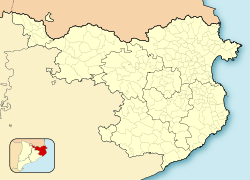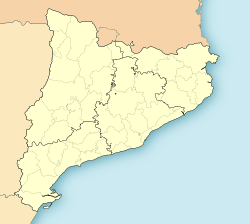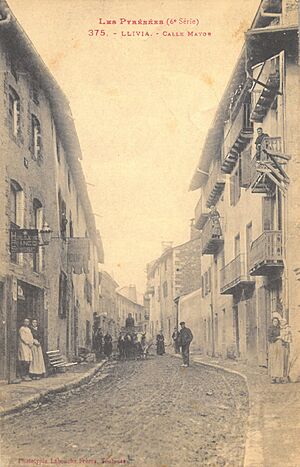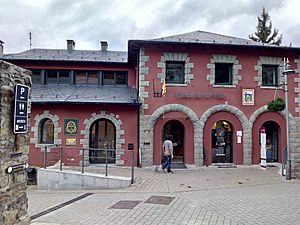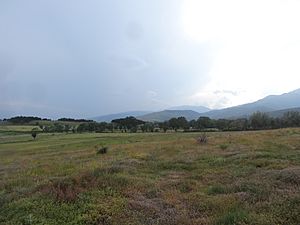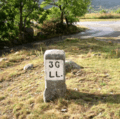Llívia facts for kids
Quick facts for kids
Llívia
|
||
|---|---|---|
|
Municipality
|
||
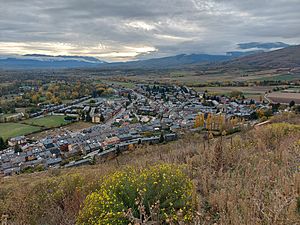 |
||
|
||
| Country | ||
| Autonomous community | ||
| Province | Girona | |
| Comarca | Cerdanya | |
| Judicial district | Puigcerdà | |
| Area | ||
| • Total | 12.9 km2 (5.0 sq mi) | |
| Elevation | 1,224 m (4,016 ft) | |
| Population
(2018)
|
||
| • Total | 1,428 | |
| • Density | 110.7/km2 (286.7/sq mi) | |
| Demonyms | Llivienc, llivienca (ca) Lliviense (es) |
|
| Time zone | UTC+1 (CET) | |
| • Summer (DST) | UTC+2 (CEST) | |
| Postal code |
17527
|
|
Llívia is a special town in Catalonia, Spain. It's unique because it's a Spanish exclave, meaning it's completely surrounded by France. Llívia is part of the Cerdanya region in the province of Girona.
In 2023, about 1,511 people lived in Llívia. It's connected to the rest of Spain by a narrow corridor, about 1.6 kilometers (1 mile) wide. This corridor goes through two French towns. The Segre river, which flows into the Spanish Ebro river, also passes through Llívia.
Contents
History of Llívia
Ancient Times
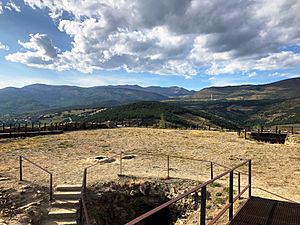
Llívia has a very long history. Long ago, it was an Iberian settlement. The Romans later called it Julia Lybica. It was the main town of the Cerdanya region in ancient times. Later, another town, Hix, became the capital in the Middle Ages.
During the Visigothic period, Llívia had a fortress called castrum Libiae. In 672, a rebel named Paul of Narbonne held this fortress against King Wamba. In the 8th century, Llívia might have been where a Muslim governor, Abdul Rahman Al Ghafiqi, fought a rebel leader. This happened before the famous Battle of Tours in 732 or 733.
Becoming an Exclave
Llívia became an exclave after a war between France and Spain. In 1659, the Treaty of the Pyrenees was signed. This treaty set the Pyrenees mountains as the border between the two countries. It gave several regions to the French Crown.
However, the treaty said that only villages would be given to France. Llívia was considered a town (vila in Catalan), not a village. This was because it used to be the ancient capital of Cerdanya. So, Llívia remained a Spanish town, even though it was surrounded by French land. This special situation was confirmed in the Treaty of Llívia in 1660.
Modern Times
For a while, during the government of Francisco Franco in Spain, people living in Llívia needed special passes to travel through France to reach the rest of Spain. Today, this is much easier. Both Spain and France are part of the Schengen Area. This means there are no border checks, and people can travel freely between the countries.
Llívia is connected to Spain by a 1.8 km (1 mile) road. Before 1995, this road was called a "neutral road." This meant both French and Spanish people could use it freely. This road is owned by both Spain and France. It's known as the N-154 in Spain and the RD68 in France.
The road has had some disagreements over the years. For example, French authorities once put up stop signs, but people who disagreed with them removed the signs overnight. This went on for several years and was known as the "war of the stop signs."
In 2017, there was a vote for Catalan independence. In Llívia, 561 out of 591 votes were in favor of independence. Spanish courts said the vote was illegal, but the police did not stop the voting in Llívia.
Esteve Pharmacy Museum
Llívia is home to a very old and special museum. It's called the Esteve Pharmacy. This pharmacy is from the 18th century and is now part of Llívia's municipal museum. The family who owned it gave it to the town. They wanted all the old items to stay in Llívia.
Records show that pharmacists have worked in Llívia since the Middle Ages. The museum has many interesting things. You can see albarelli, which are special ceramic jars used in old pharmacies. There are also antique medicines and one of Europe's most important collections of old prescription books.
Education
Llívia has a school called Escola Jaume I. The original school building was built in the 1950s. As of 2016, a new school building was constructed. It has a ground floor of about 500 square meters (5,380 sq ft) and a second floor of about 250 square meters (2,690 sq ft).
Images for kids
-
Boundary marker between Spain and France, for the municipalities of Llívia (Girona) and Angoustrine-Villeneuve-des-Escaldes (Pyrénées-Orientales)
See also
 In Spanish: Llivia para niños
In Spanish: Llivia para niños



